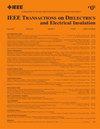Effects of Thermo-Oxidative Aging on the Dielectric Property and Electrical Breakdown of Epoxy Resin Using in High-Voltage Equipment
IF 3.1
3区 工程技术
Q2 ENGINEERING, ELECTRICAL & ELECTRONIC
IEEE Transactions on Dielectrics and Electrical Insulation
Pub Date : 2024-11-18
DOI:10.1109/TDEI.2024.3501997
引用次数: 0
Abstract
In this article, the effects of thermo-oxidative aging on the dielectric properties of epoxy resin are investigated at 180 °C under different durations. In the early stage of aging (0–168 h), the dielectric properties of epoxy resin are slightly improved, which are characterized by the reduction of dielectric loss and conductivity and the slightly enhancement of breakdown strength. These are attributed to the molecular rearrangement and postcuring reactions inside the epoxy resin, as evidenced by the improved glass transition temperature. With the continuous increase of thermal aging time, oxidative decomposition and scission reactions start to dominate. The cross-linked network of epoxy resin is gradually destroyed, leading to the increase of carrier quantity and the reduction of trap energy level and density. The dielectric polarization and charge injection are intensified, while the partial discharge initiation voltage (PDIV) and breakdown strength are decreased significantly. After aging for 1440 h, the conductivity could be increased by 59.64%, and the breakdown strength is decreased by 18.14%. The insulation performance of epoxy resin is determined by the competition results of the molecular rearrangement, postcuring, and oxidative cleavage reactions during thermal aging, which could provide a theoretical basis for the aging assessment of epoxy resin for high-voltage applications.热氧化老化对高压设备用环氧树脂介电性能和击穿的影响
在180℃下,研究了不同时间下热氧化老化对环氧树脂介电性能的影响。在老化初期(0 ~ 168 h),环氧树脂的介电性能略有改善,表现为介电损耗和电导率降低,击穿强度略有提高。这是由于环氧树脂内部的分子重排和固化后反应,如玻璃化转变温度的提高所证明的。随着热老化时间的不断增加,氧化分解和裂解反应开始占主导地位。环氧树脂的交联网络逐渐被破坏,导致载流子数量增加,陷阱能级和密度降低。介质极化和电荷注入增强,局部放电起始电压(PDIV)和击穿强度显著降低。时效1440 h后,电导率提高59.64%,击穿强度降低18.14%。热老化过程中分子重排、后固化和氧化裂解反应的竞争结果决定了环氧树脂的绝缘性能,可为高压环氧树脂的老化评价提供理论依据。
本文章由计算机程序翻译,如有差异,请以英文原文为准。
求助全文
约1分钟内获得全文
求助全文
来源期刊
CiteScore
6.00
自引率
22.60%
发文量
309
审稿时长
5.2 months
期刊介绍:
Topics that are concerned with dielectric phenomena and measurements, with development and characterization of gaseous, vacuum, liquid and solid electrical insulating materials and systems; and with utilization of these materials in circuits and systems under condition of use.

 求助内容:
求助内容: 应助结果提醒方式:
应助结果提醒方式:


